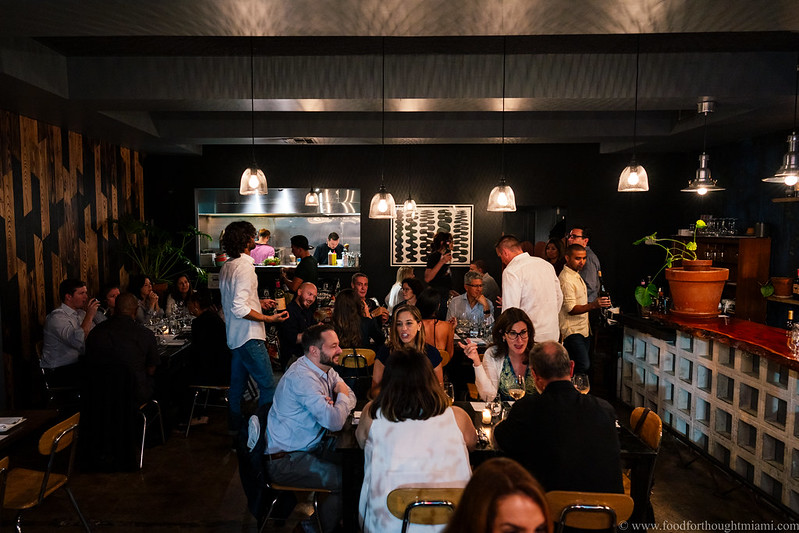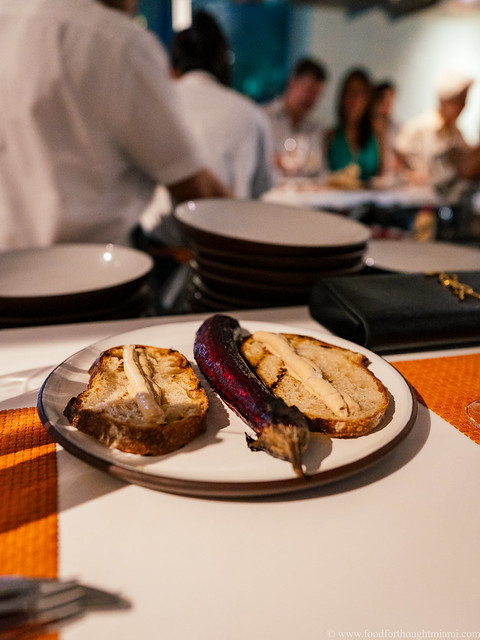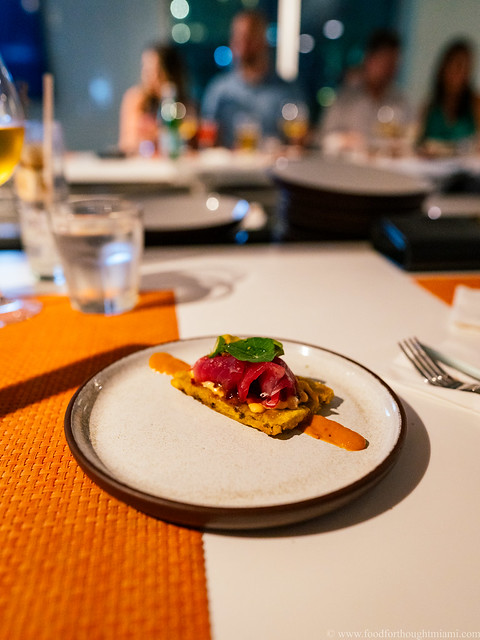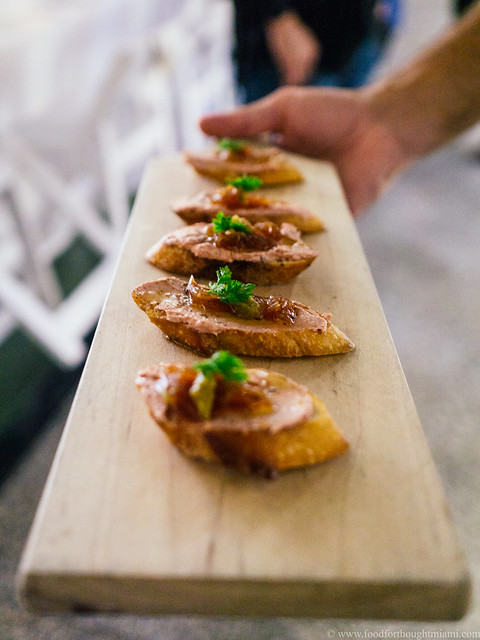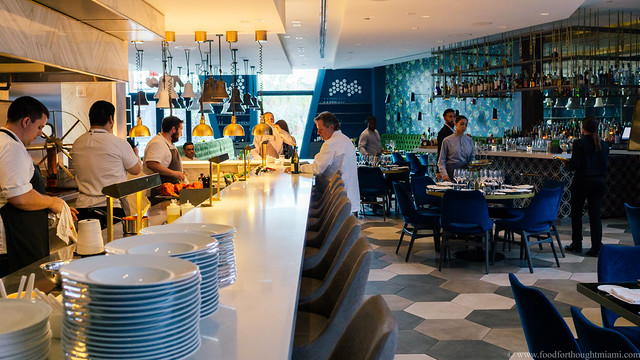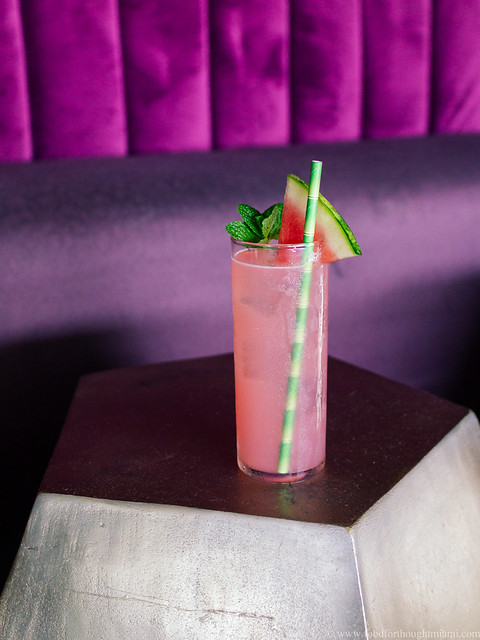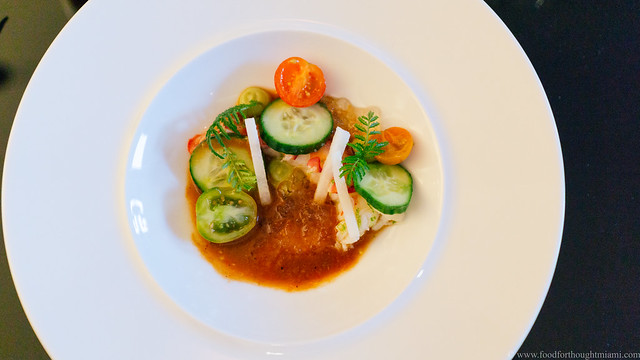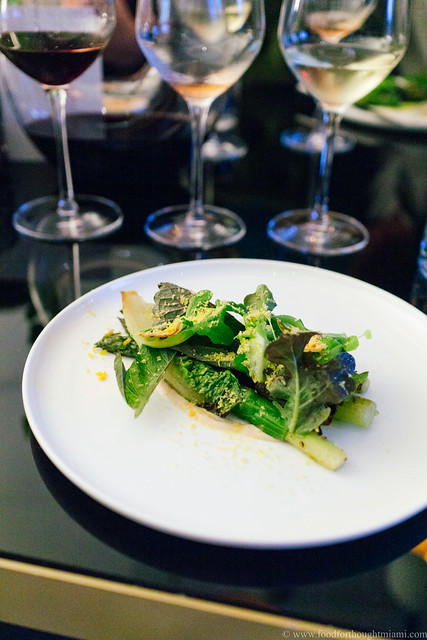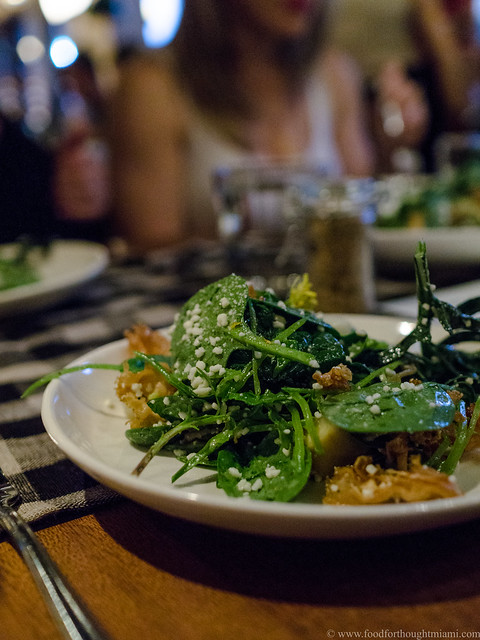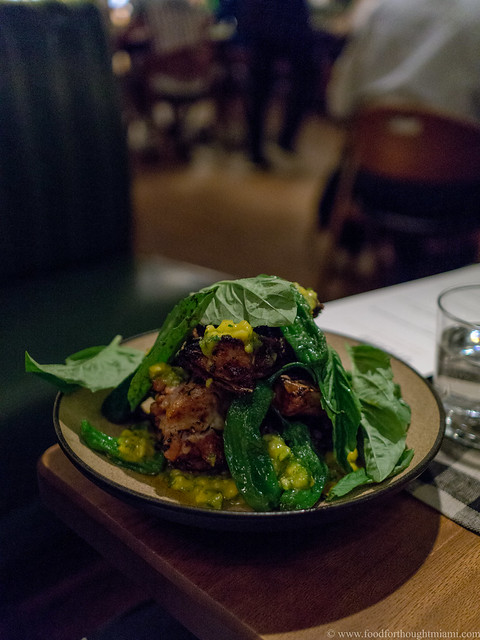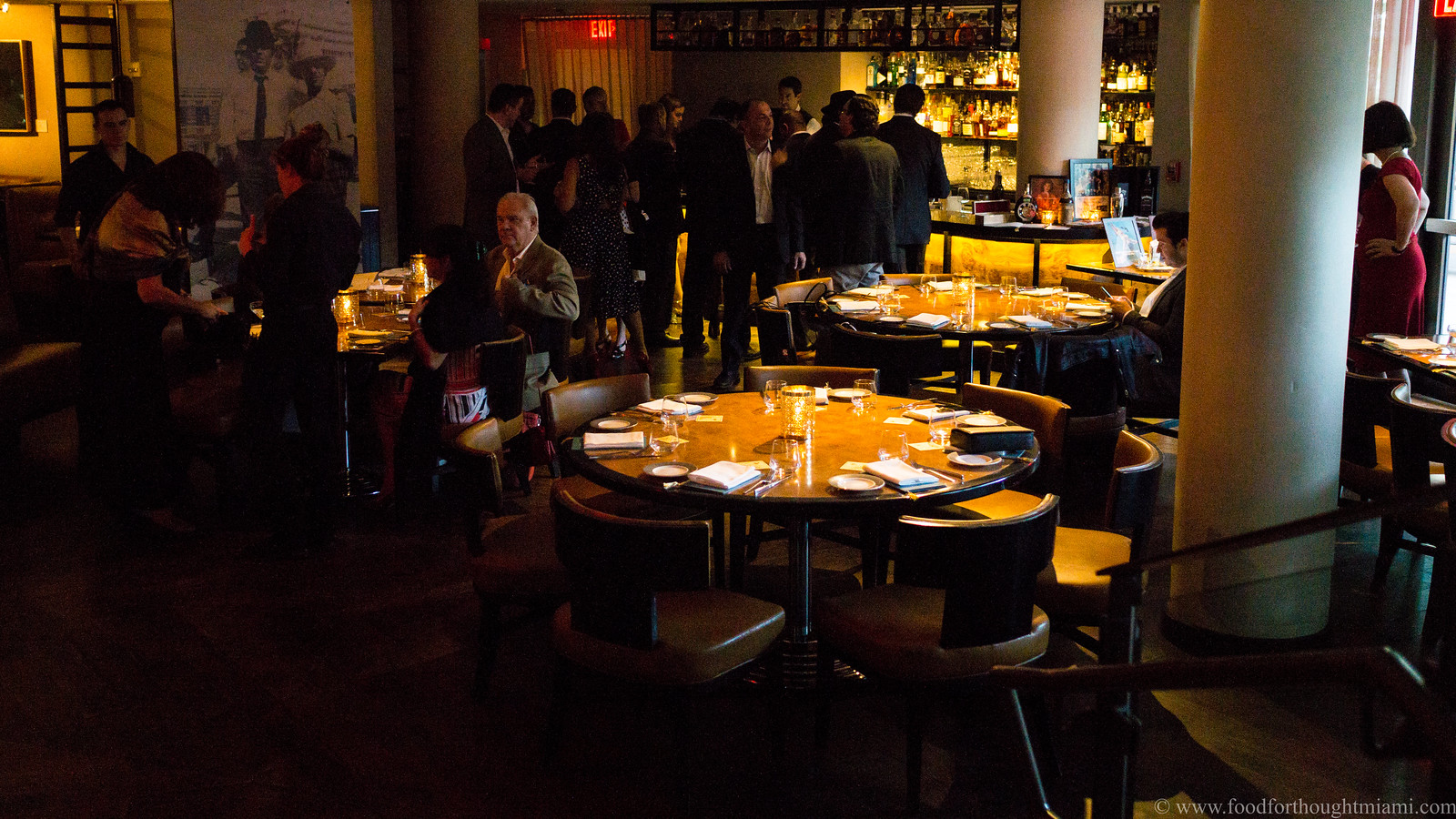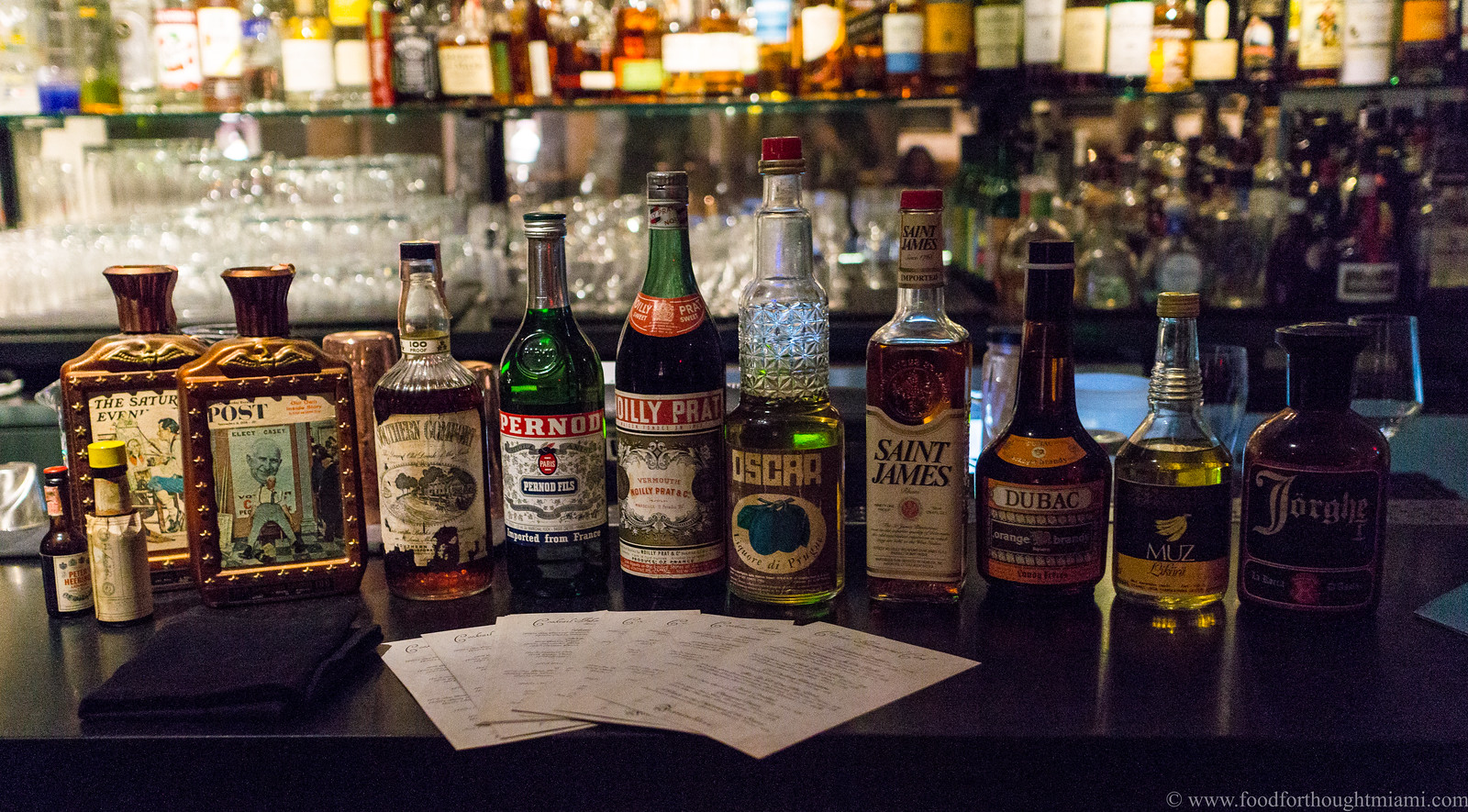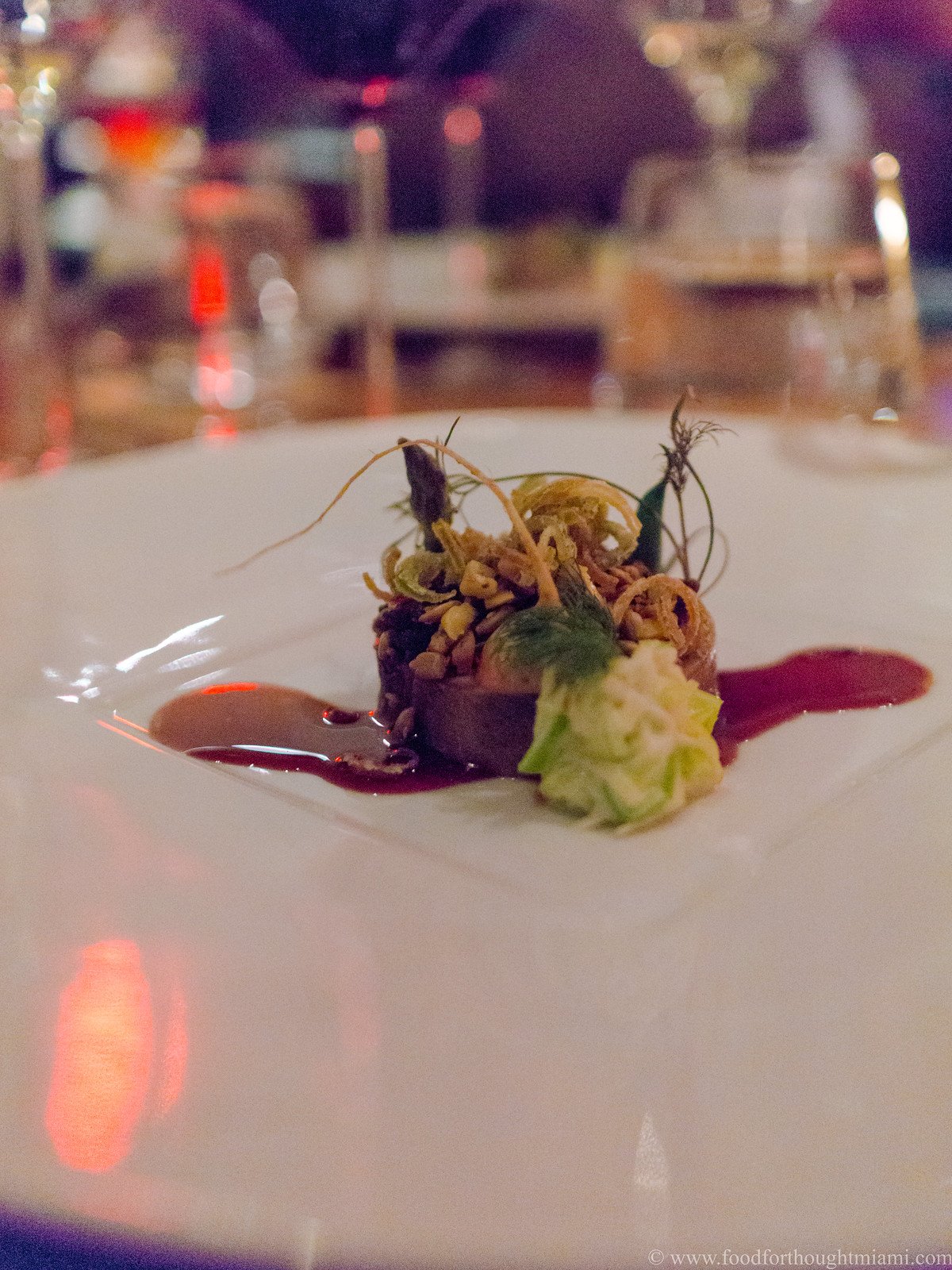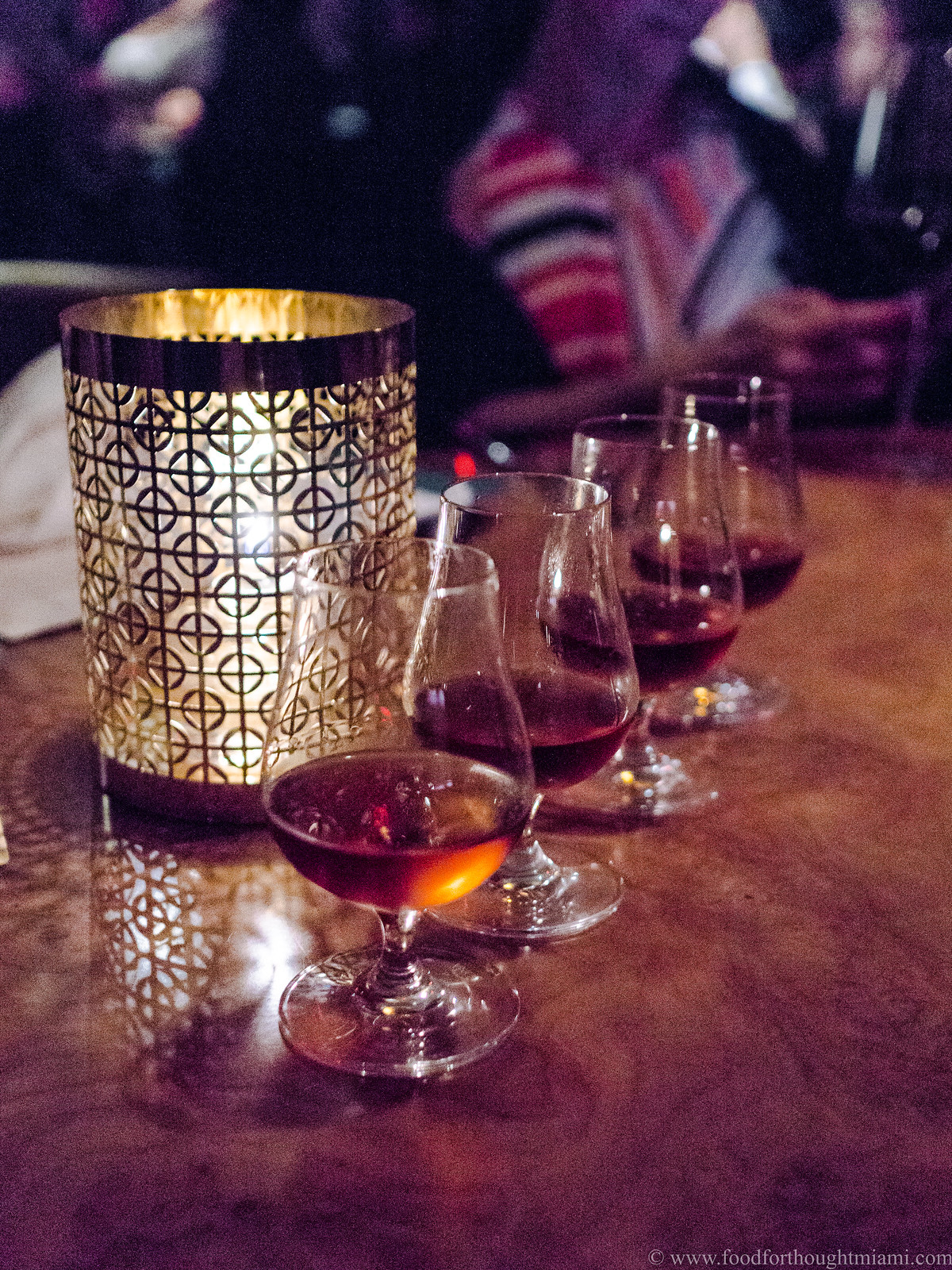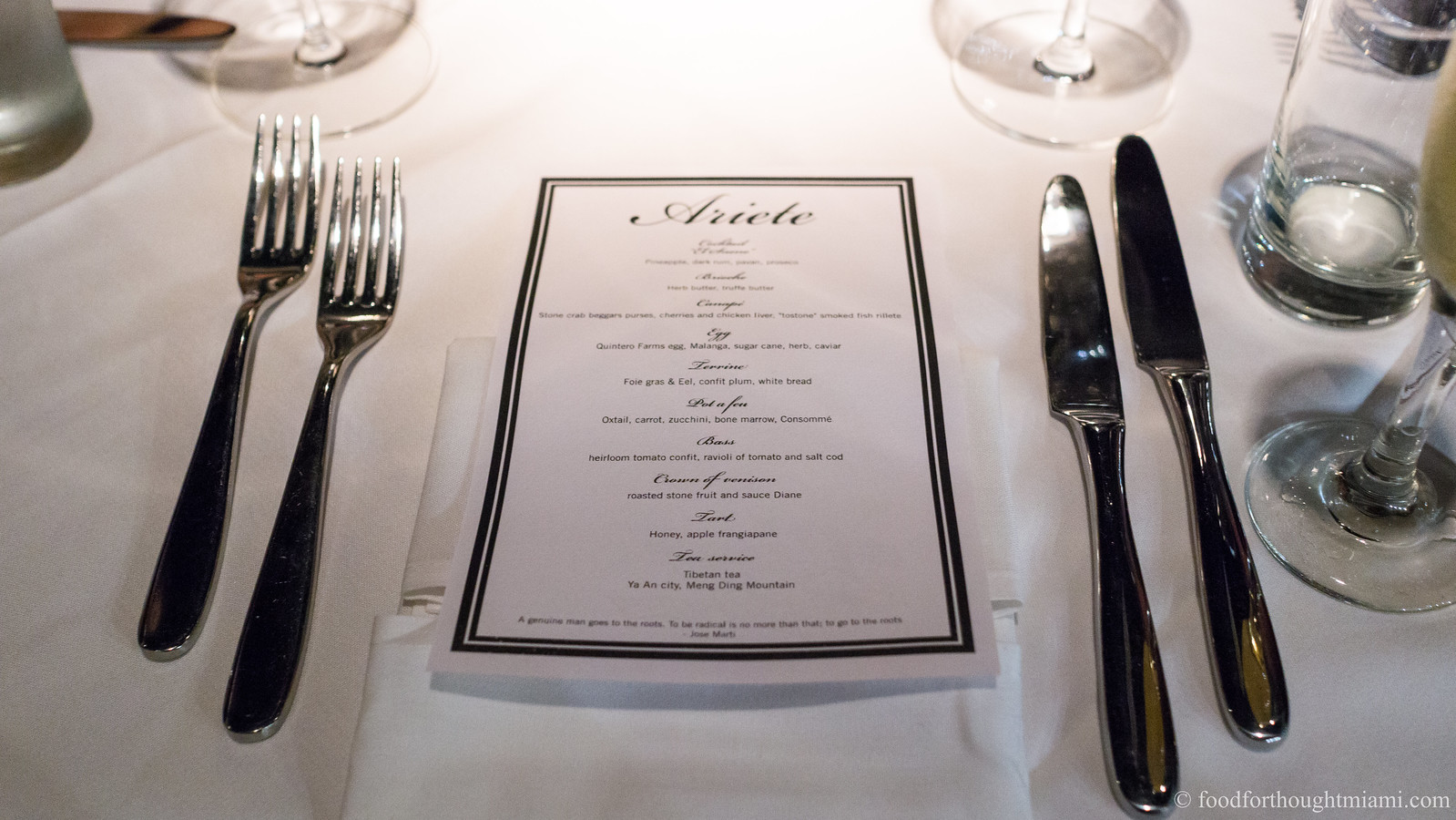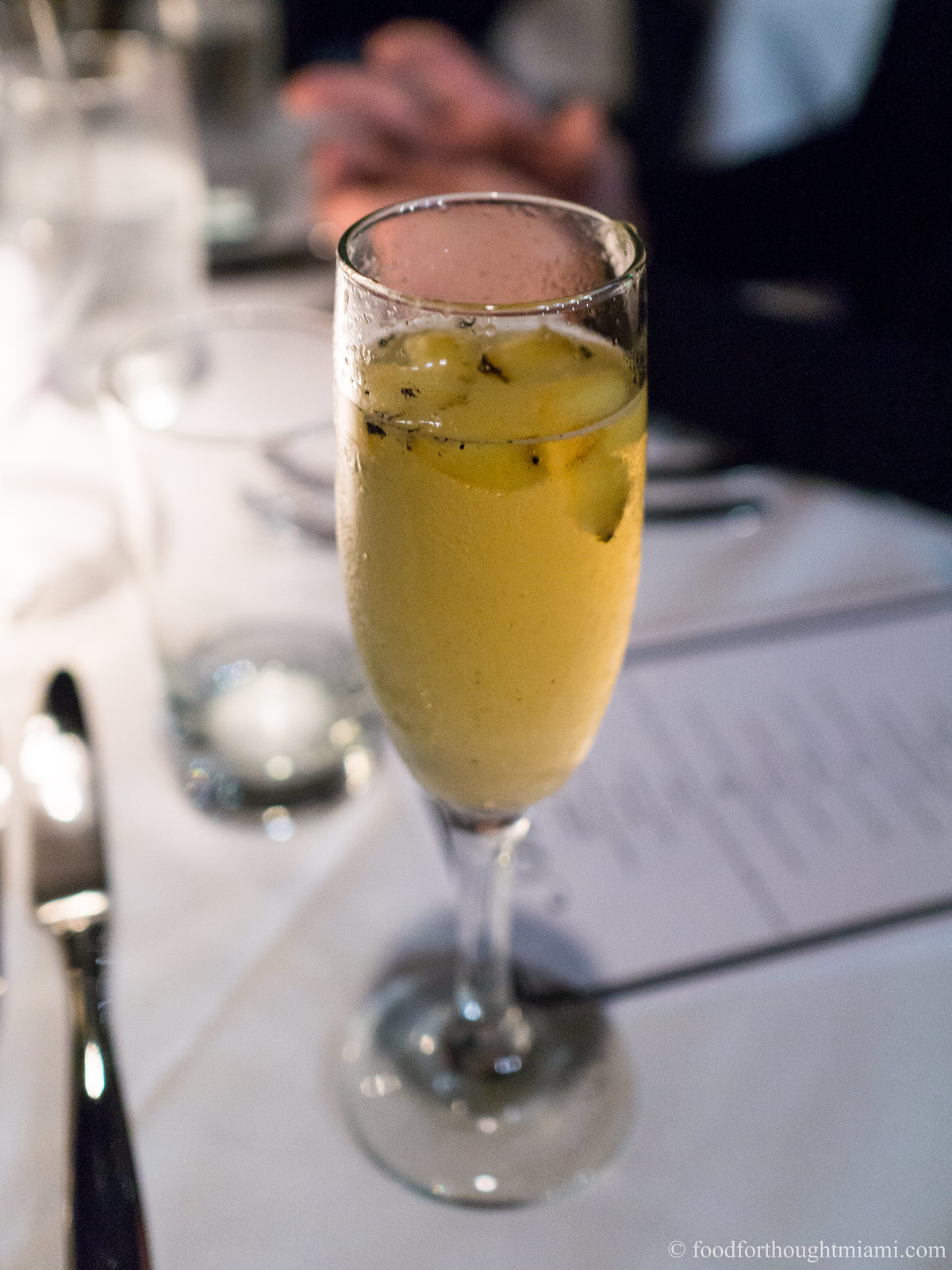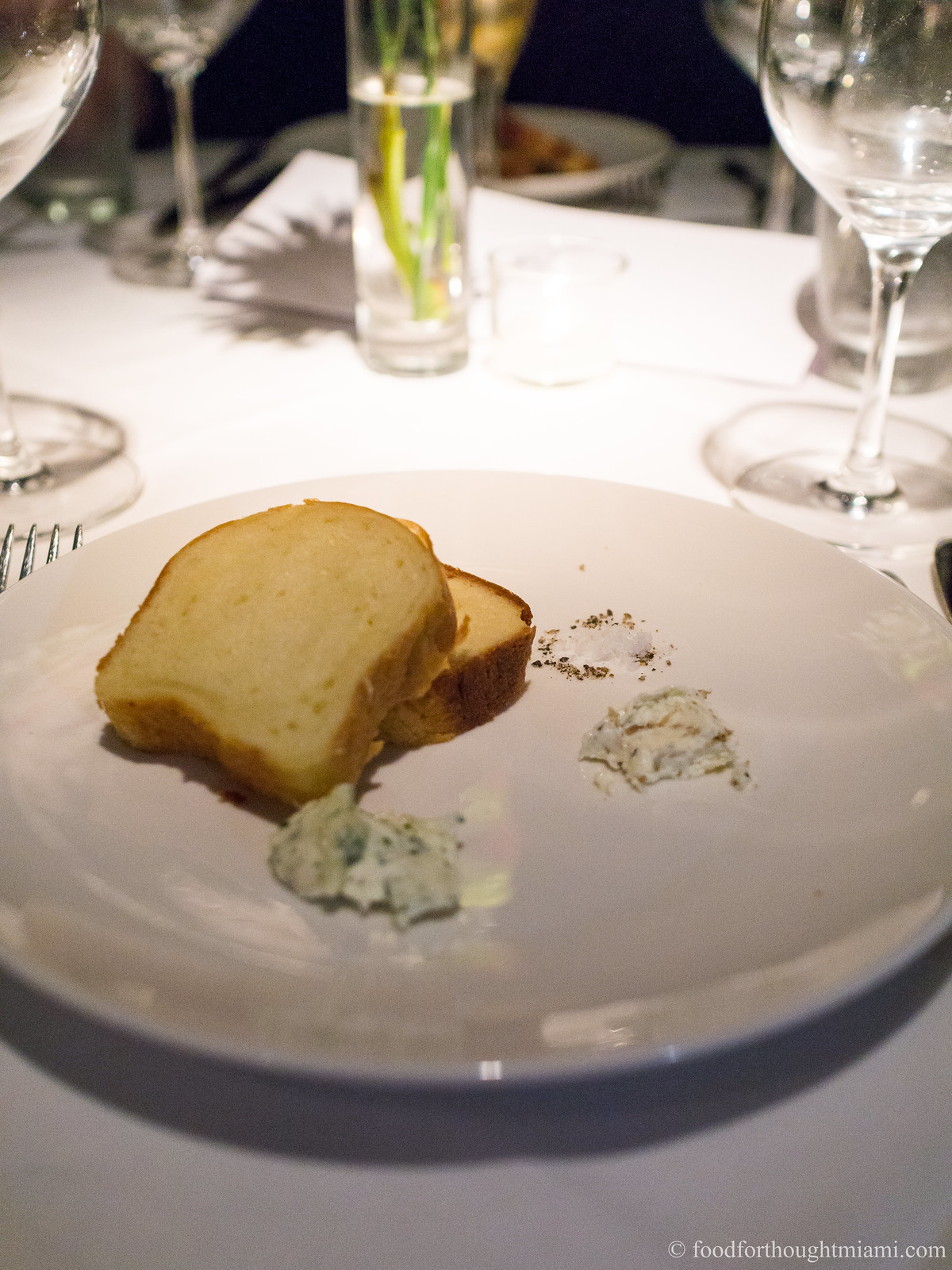Showing posts with label Cobaya. Show all posts
Showing posts with label Cobaya. Show all posts
Saturday, December 21, 2019
Cobaya Amarilla with Chefs Santiago Gomez and Carlos Garcia
One of our goals with the Cobaya dinner group is to provide an alternative to the typical restaurant experience, but even so, most of the time we're doing it within restaurants. We're usually working with restaurant chefs, they've already got their space and equipment and crew, and it's a whole lot easier for everyone. But some of our most interesting experiences come when we get out of the restaurants, despite – or maybe in part because of – the challenges and constraints.
Santiago Gomez is the chef of high-end Mexican spot Cantina la Veinte in Brickell and its fast casual sibling, Tacology. Carlos Garcia – who hosted us earlier this year for Cobaya Experiment #77 – is the chef of Obra, and one of Venezuela's top chefs. When they're not in their restaurants, they like to host private dinners together at Gomez's home - "La Casa Amarilla." (And on top of that, Gomez and his wife Camila Basmagi started a non-profit called "Recipes for Change" which organizes cooking events, workshops and fundraisers to help feed at-risk communities - more on that below).
(continued ...)
Saturday, November 30, 2019
Cobaya Arson with Deme Lomas
Almost exactly four years ago, we did a Cobaya dinner with Chef Deme Lomas at Niu Kitchen, the small, Catalan inspired restaurant he opened with Karina Iglesias and Adam Hughes in 2014. Since that time, as Niu has continued to thrive, the team opened up Arson right down the block, a restaurant dedicated to cooking with live fire. We figured it was time for another round with Deme, and brought forty guinea pigs to Arson earlier this month.
(You can see all my pictures in this Cobaya Arson with Deme Lomas flickr set).
It was another great experience – interesting, delicious food all touched by the flames, with equally interesting, exciting wines supplied by Arson and Niu's wine director, GM and ringmaster, Karina Iglesias. Here's what we had:
(continued ...)
Sunday, September 22, 2019
Cobaya Taymor at Three
For Cobaya Experiment #78, we had an out-of-town chef who came to Miami to immerse himself in the local flavors. For Experiment #79 earlier this month, we had sort of the converse: Ari Taymor, of Santa Monica's Little Prince, brought some Southern California to South Florida for our dinner at Three in Wynwood, where he is doing a stint as "guest chef." Two different approaches: two great meals.
(You can see all my pictures in this Cobaya Taymor at Three flickr set).
For someone who is still on the front end of his career, Taymor's path has already taken plenty of twists and turns. The California native was fired from his first cooking job, as an extern at Susanne Goin's Lucques, but later made his way into some of San Francisco's best kitchens – Flour + Water, Bar Tartine, as well as a half-year stint at La Chassagnette in Arles, France. Taymor returned to L.A. to open his first restaurant, Alma, in 2012. The tiny, 8-table spot started as a pop-up, and was built and operated on a shoestring. It was also beloved by critics and food media, getting named Bon Appetit's "Best New Restaurant in America" the next year. But success is a fickle mistress, and despite the accolades, the restaurant struggled financially, was beset by litigation, and had trouble filling seats, possibly a victim of the "Nobody goes there any more, it's too crowded" mentality. Taymor has spoken openly about the physical and psychological toll, too, which included an emergency room visit with a bleeding ulcer.[1]
By 2015, Alma in its original incarnation had closed. It resurfaced for a time as a pop-up in the Standard Hotel in West Hollywood, until Taymor decided he didn't want to run a hotel restaurant. So he pivoted once again. Little Prince began as a weekends-only brunch pop-up, inspired by the all-day cafés he saw during a visit to Australia, and a year later, it now has a permanent home in Santa Monica.
Clearly, Taymor is a restless spirit: who comes to Miami in the middle of the summer to cook in someone else's restaurant? But that's exactly what he did, partnering up with Three restaurant in Wynwood to do some special menus, dinners and cooking classes. Our Cobaya group had just made a visit to Three almost exactly a year ago, where one of my culinary heroes, Norman Van Aken, cooked for us. We made a return visit to see what Ari Taymor was up to.
To start, baked oysters with braised bacon, camouflaged underneath a blanket of frothy, creamy smoked potatoes, red veined sorrel giving a pop of color and tartness.
Next, thinly shaved slivers of Col. Bill Newsom's country ham, plated with curled ribbons of cucumber, juicy melons, creamy burrata, fresh herbs and a pink peppercorn vinaigrette. This was deceptively simple – a riff on prosciutto and melon, after all – but compulsively good eating, balancing salty, sweet, fat, and acid with some vegetal crunch.
(continued ...)
Friday, August 23, 2019
Cobaya Isabela with Chef Jose Ramirez-Ruiz
Sometimes it takes an outsider to see the things you don't always see in yourself.
José Ramirez-Ruiz was a New Yorker through and through. He refined his cooking skills at some of the city's top restaurants – Per Se, Chef's Table at Brooklyn Fare, Isa – before going out on his own in 2012 with a pop-up in Williamsburg called "Chez José." Chez José eventually ripened into a full-blown restaurant called Semilla in late 2014. Despite its diminutive size – there was only seating for 18 around a U-shaped counter, and the staff consisted of a grand total of two cooks and two servers – Semilla earned accolades disproportionate to its stature. Pete Wells praised its vegetable-forward tasting menus in a two-star New York Times review in early 2015,[1] Eater's Ryan Sutton issued a glowing four-star review a couple months later, naming Semilla "New York's Next Great Restaurant,"[2] Eater's Bill Addison included it in his "21 Best New Restaurants in America," Bon Appetit included it in its top 10 "Best New Restaurants of 2015," and by that fall, Michelin awarded the restaurant a star.
But Semilla was not built to last – Ramirez-Ruiz's partner Pamela Yung, who handled Semilla's highly regarded breads and desserts, left late the following year, and by March of 2017 the restaurant was closed. In the aftermath, Ramirez-Ruiz found his way down to Miami on a corporate consulting gig. Fortunately for us, he's decided to stick around for a while, and recently has devoted himself full-time to opening a new restaurant – Isabela – in Little Haiti. Earlier this month, we got him to do a dinner with our Cobaya group that provided a preview of what's to come.
(You can see all my pictures from the dinner in this Cobaya Isabela with Chef Jose Ramirez-Ruiz flickr set).
Unlike many out-of-town chefs who have rolled into Miami like emperors visiting the backwards colonies, Ramirez-Ruiz arrived with humility and curiosity:
While he works on getting Isabela off the ground, a nearby space at Little River Miami played host for our dinner. I've now been here for a few different things – Eat Here Now's Friday lunches, Scott Linquist's Chivo! goat barbacoa – and while it's pretty bare-bones at the moment, the space also has some great potential. Lots of foliage from plant and floral designer Madre Selva, which keeps a studio nearby, helped soften the rough edges.
Ramirez-Ruiz started things off with a round of snacks, all brought out to the tables at once: delicate little mussels swimming in paprika-laced oil with sautéed onions, in the style of the wonderful canned seafood conservas of Spain and Portugal; flat-out delicious green olives stuffed with shrimp paste and warmed in the wood oven; rounds of fresh cheese also roasted in the oven and doused in a lemon vinaigrette, a sort of saganaki minus the flaming tableside presentation; some Wigwam country ham from Edwards Smokehouse;[3] and freshly baked sourdough bread, served with an army-green moringa butter. I've been told that moringa doesn't have a lot of flavor on its own, so maybe there was something else in here, but it had an intriguing, vegetal thing going on that I kept on coming back to for more.
I'd been to Ramirez-Ruiz's pop-up dinners at All Day and Jaguar Sun, and each time he'd served some variation on this dish: a creamy plantain soup, with melting comté cheese and crispy plantain "crunchies." It eats like a crazy hybrid of a Caribbean sopa de platano and a French onion soup, and this was possibly my favorite iteration.
(continued ...)
Sunday, August 4, 2019
a decade of cobaya
It was exactly ten years ago to the day that Steven (a/k/a Chowfather), Steve (a/k/a Blind
Mind) and I hosted our first Cobaya "underground" dinner. Those were interesting times. Following the financial crisis of 2007-08, the food world seemed to be at something of an inflection point. Chefs like David Chang were pulling the chair out from the pretensions of fine dining and replacing it with a hard, backless stool in front of the kitchen counter at Momofuku Ko. Food trucks were a big thing, where aspiring restaurateurs could pursue their dreams without the big capital outlay required for a brick-and-mortar build-out. The hegemony that newspapers exercised over public discourse on restaurants was being undermined from one side by Yelp, and from the other by these things called "blogs" where anyone with some rudimentary knowledge of how to operate a computer could publish their thoughts to the internet. Many would do so with actual thoughtfulness and insight, and often with a side of snark.[1] Instagram didn't even exist yet.
Locally, Michelle Bernstein and Michael Schwartz were the queen and king, respectively, of Miami dining, with bookend Beard Awards to prove it (Michelle won Best Chef: South in 2008, Michael won the same award in 2010).[2] Since then, Michael's opened more restaurants than I can count,[3] while Michelle took a different direction; she recently opened Cafe La Trova on Calle Ocho with cantinero and longtime compadre Julio Cabrera (recently named Tales of the Cocktail's Bartender of the Year), and continues to run a high-end catering operation, but these days you're equally likely to see her on T.V., hosting "Check, Please!" or "SoFlo Taste," as in a restaurant kitchen. Good for her; it's a crazy life. Meanwhile, back in 2009, many of those who are now among Miami dining's most prominent names were still sharpening their knives: to name just a few, Brad Kilgore was working his way through some of Chicago's top kitchens, Zak Stern (a/k/a Zak the Baker) was traipsing around Europe, making cheese, herding goats, and occasionally baking bread at my kids' summer camp, Jose Mendin was still a year away from opening the original PubBelly.
It was a long time ago – longer than the lifespan of most restaurants.
I've told the Cobaya origin story many times when folks ask, "How did you start doing this?", but never written it down. Many of you have probably heard it before. The whole thing started in the valet circle of a Sunny Isles hotel. A couple chefs, Kurtis Jantz and Chad Galiano, had cobbled together a group of "food-focused locals" to be their focus group for a new restaurant concept. They'd found most of us online, probably primarily via Chowhound, which back in the day actually hosted a somewhat lively food discussion on its boards. That was how most of us knew each other as well, though a few of us had met in person. As the Steves and I were waiting for our cars at the end of the evening, we started talking about the then-current trend of "underground dining" groups.
Two questions triggered it: "Why not here?" And then: "Why not us?" And just like that, we decided to do it ourselves. We posted something on a Google message board that I'd used to organize a few other get-togethers,[4] started a website, and posted a mission statement:
The goal here is a very simple one - to get talented chefs to cook great, interesting, creative meals for an audience of adventurous, open-minded diners. That may happen inside a restaurant, it may happen outside of one. It may be a multi-course tasting menu, it may be a family-style whole hog dinner (here's hoping). For those who question the "underground" street cred of this mission, those questions are perfectly legitimate. My answer is, "I don't care." We're not limiting ourselves to meals cooked in abandoned warehouses in secret locations disclosed the day before the dinner; we're also not limiting ourselves to white tablecloths and silverware changed between every course. We're very open-minded that way: all that matters is if the food is good, and we think there's enough similar-minded folks to make that game plan sustainable.
Every invitation comes with a disclaimer: there is no "menu". There are no choices. You'll be eating what the chef chooses to make for the night. If you have food related allergies, strict dietary requirements, religious restrictions; are salt sensitive, vegetarian, pescatarian, or vegan; don't like your meat cooked medium rare, or are pregnant: this meal is probably not for you. Do not expect white-glove service. Don't ask for your sauce on the side. Just come and enjoy.[5]Truth is, we hadn't quite honed our modus operandi yet – we let everyone know the restaurant that it was going to be at, and a preview menu got posted a couple days in advance – but the basic idea was that the chefs were going to get to cook whatever they wanted and the folks who showed up would get to eat it. We had no idea what kind of reaction it would get, but we wound up with a group of sixteen who wanted in.
On August 4, 2009, we hosted our first "Cobaya" dinner at Talula. Andrea Curto-Randazzo was the chef, along with her then sous chef, Kyle Foster.[6] It is still one of my favorite Cobaya meals, and I still pine for that tripe risotto.
What we found out is that there was actually tremendous demand in Miami for this kind of thing. We announced our next event a couple months later, and got so many responses that we added a second seating for the following night. Chef Jeremiah Bullfrog wound up doing two rounds of seven courses for 36 diners in a penthouse suite in Midtown Miami. I brought Frod Jr., who was 12 years old at the time, along to one of those, and he still remembers Jeremiah offering him a cigar and a beer as we hung out on the balcony post-service.[7]
Since then, we've put on a total of 77 of these "experiments." We've worked with some of Miami's most highly regarded chefs,[8] an even greater number of skilled and creative but less-celebrated talents, and the occasional visitor from places further afield.[9] We've had Andrew Zimmern join us for a dinner, which wound up being featured on his show "Bizarre Foods America,"[10] and then later cook for us at a couple events we co-hosted with the South Beach Wine and Food Festival. We've eaten with our hands at "kamayan" Filipino feasts in fancy South Beach restaurants, and we've eaten at a backyard farm in Homestead.
We've been served pig's heads, lamb's heads, goat's heads, pig's brains, veal brains, pig skin noodles, lamb's livers, rabbit's livers, beef tendon chicharrones, sweetbreads, duck testicles, mushroom dinuguan, morcilla toast, beef heart tartare, grasshoppers, silkworms, waterbugs, ant eggs, abalone, geoduck, turtle, blowfish, suckling pigs and smoking cows and kangaroo and rabbit and venison and goat, not nearly enough tripe, and enough foie gras to stuff a flock of geese. We haven't actually had guinea pig yet, unless you want to count a guinea hen stuffed with pig (a noble effort). We've had a dinner with truffles for every course, and another where we drank liquors from the 1950's-1970's with every course, and another – Cobayapalooza! – with seven different chefs for each course.
We've had roughly a thousand different people attend our experiments, and now routinely have to deal with the fortunate but nonetheless demanding challenge of receiving 250-350 requests for the 25-35 spots we typically have available for each of these events. We've spent a lot of time and effort trying to find ways to handle those requests fairly and in a way that maximizes the most people's opportunity to join us, while also making sure we can timely fill the spots that we have.[11]
Through it all, we've remained faithful to that mission statement, encapsulated in that first sentence: "The goal here is a very simple one - to get talented chefs to cook great, interesting, creative meals for an audience of adventurous, open-minded diners." I feel very fortunate to have been able to do exactly that for the past ten years, and to meet and eat with so many wonderful people along the way. Thanks for your support.
[1] R.I.P. "Eat Me Daily."
[2] No South Florida chef has won the award since 2010, though I think Miami can still claim as one of its own the wonderful Nina Compton, 2018's winner for her New Orleans restaurant Compere Lapin.
[3] Let me try from memory, without cheating: Michael's Genuine, Harry's Pizza, Ella, Genuine Pizzas in Coconut Grove, Atlanta, and Cleveland (?), Amara at Paraiso, Tigertail & Mary, and Traymore at the Como. (edited to add: I was close. The Atlanta Genuine Pizza closed but there's the original Harry's in the Design District plus Coconut Grove, Aventura, and Dadeland; and it's a Michael's Genuine that recently opened in Cleveland, not a Genuine Pizza. And while I thought Schwartz was no longer affiliated with Fi'lia because of a split with SBE, it's still included on the Genuine Kitchen website?). (edited again to add: so literally a day after I posted this, Schwartz announced he's closing the Dadeland Harry's. I guess I wasn't the only one not paying attention.)
[4] Again reflecting the centrality of Chowhound back then, we called these events "chowdowns," as they did on the other Chowhound regional boards, and I wound up with the idiotic "miamichowdown" email address that I still use for food-related things.
[5] Some of this was unapologetically stolen from an event announcement from Chef Jeremiah Bullfrog, who should probably see if he knows any lawyers he can talk to.
[6] Talula closed the following year, and it is still one of my all-time favorite Miami restaurants. Andrea continues to run Creative Tastes Catering with her chef husband Frank Randazzo. Kyle moved to Denver, where he's chef-owner of Julep. Kyle made some of the best offal dishes I've ever had, and I'm glad he's continuing that work at the Southern-inspired Julep, where the menu includes scrapple fries, chicken tail skewers, and rocky mountain oysters rockefeller. Another name you might recognize from the Talula kitchen: the outstanding pastry chef Antonio Bachour, though I think by the time of our dinner there he'd already moved across the street to work at the W South Beach.
[7] Another great connection from that dinner: the owner of the Midtown Miami condo that hosted our dinner ran a digital design company. One of their web developers was at the event and struck up a friendship with Jeremiah, then began working for him on the side, and ultimately wound up devoting himself full-time to the food business. Steve Santana – a/k/a @SliceDiceCode – now runs Taquiza, making the best tortillas in Miami, with locations in South Beach, North Beach and at The Citadel. I'd like to think that Cobaya can claim at least a small measure of responsibility for advancing Miami's taco game.
[8] A special acknowledgment here needs to go to Michelle Bernstein, who agreed to do a dinner with us back in 2011, when we'd been at it less than two years and hosted less than a dozen of these things.
[9] Sometimes when I look back at the list of experiments, I'm still flabbergasted by the names I see there: Bernstein, Schwartz, Norman Van Aken (a longtime culinary idol of mine), Nina Compton, Andrew Carmellini, Francis Mallmann, Carlo Mirarchi, Jon Shook and Vinny Dotolo, Jeremiah Stone and Fabian Von Hauske, Justin Smillie, Katsuya Fukushima, Alex Talbot. What a thrill it's been to be able to approach these people and just say: "Cook for us."
[10] Zimmern gave a nickname to the sous chef working that dinner at Azul: "Wall Street," for his hair, which he wore slicked back, Gordon Gekko style. "Wall Street" no longer wears his hair slicked back, but found his way to success: Brad Kilgore now heads up Alter, Brava, Kaido and Ember.
[11] It continues to be a perennial problem that people ask for spots and then don't book them, so that we're always left to back-fill from the wait-list. When I hear restaurateurs complain about reservation no-shows, I listen with complete empathy.
[2] No South Florida chef has won the award since 2010, though I think Miami can still claim as one of its own the wonderful Nina Compton, 2018's winner for her New Orleans restaurant Compere Lapin.
[3] Let me try from memory, without cheating: Michael's Genuine, Harry's Pizza, Ella, Genuine Pizzas in Coconut Grove, Atlanta, and Cleveland (?), Amara at Paraiso, Tigertail & Mary, and Traymore at the Como. (edited to add: I was close. The Atlanta Genuine Pizza closed but there's the original Harry's in the Design District plus Coconut Grove, Aventura, and Dadeland; and it's a Michael's Genuine that recently opened in Cleveland, not a Genuine Pizza. And while I thought Schwartz was no longer affiliated with Fi'lia because of a split with SBE, it's still included on the Genuine Kitchen website?). (edited again to add: so literally a day after I posted this, Schwartz announced he's closing the Dadeland Harry's. I guess I wasn't the only one not paying attention.)
[4] Again reflecting the centrality of Chowhound back then, we called these events "chowdowns," as they did on the other Chowhound regional boards, and I wound up with the idiotic "miamichowdown" email address that I still use for food-related things.
[5] Some of this was unapologetically stolen from an event announcement from Chef Jeremiah Bullfrog, who should probably see if he knows any lawyers he can talk to.
[6] Talula closed the following year, and it is still one of my all-time favorite Miami restaurants. Andrea continues to run Creative Tastes Catering with her chef husband Frank Randazzo. Kyle moved to Denver, where he's chef-owner of Julep. Kyle made some of the best offal dishes I've ever had, and I'm glad he's continuing that work at the Southern-inspired Julep, where the menu includes scrapple fries, chicken tail skewers, and rocky mountain oysters rockefeller. Another name you might recognize from the Talula kitchen: the outstanding pastry chef Antonio Bachour, though I think by the time of our dinner there he'd already moved across the street to work at the W South Beach.
[7] Another great connection from that dinner: the owner of the Midtown Miami condo that hosted our dinner ran a digital design company. One of their web developers was at the event and struck up a friendship with Jeremiah, then began working for him on the side, and ultimately wound up devoting himself full-time to the food business. Steve Santana – a/k/a @SliceDiceCode – now runs Taquiza, making the best tortillas in Miami, with locations in South Beach, North Beach and at The Citadel. I'd like to think that Cobaya can claim at least a small measure of responsibility for advancing Miami's taco game.
[8] A special acknowledgment here needs to go to Michelle Bernstein, who agreed to do a dinner with us back in 2011, when we'd been at it less than two years and hosted less than a dozen of these things.
[9] Sometimes when I look back at the list of experiments, I'm still flabbergasted by the names I see there: Bernstein, Schwartz, Norman Van Aken (a longtime culinary idol of mine), Nina Compton, Andrew Carmellini, Francis Mallmann, Carlo Mirarchi, Jon Shook and Vinny Dotolo, Jeremiah Stone and Fabian Von Hauske, Justin Smillie, Katsuya Fukushima, Alex Talbot. What a thrill it's been to be able to approach these people and just say: "Cook for us."
[10] Zimmern gave a nickname to the sous chef working that dinner at Azul: "Wall Street," for his hair, which he wore slicked back, Gordon Gekko style. "Wall Street" no longer wears his hair slicked back, but found his way to success: Brad Kilgore now heads up Alter, Brava, Kaido and Ember.
[11] It continues to be a perennial problem that people ask for spots and then don't book them, so that we're always left to back-fill from the wait-list. When I hear restaurateurs complain about reservation no-shows, I listen with complete empathy.
Saturday, July 20, 2019
Cobaya Obra with Chef Carlos Garcia
For years, Chef Carlos Garcia ran what was generally regarded as one of the top dining destinations in Latin America in his hometown of Caracas, Venezuela. Between 2013-2016, his restaurant Alto was a regular on the Pellegrino "Latin America's 50 Best Restaurants" list. But Venezuela, wracked by political and economic strife, has been a challenging place to live, much less run a restaurant. Like many others fortunate enough to have the opportunity, Garcia found a second home here in Miami, opening a restaurant in Brickell, Obra Kitchen Table, last year.
Despite everything happening at home, Garcia has managed to keep Alto open while running Obra here – no easy feat amidst protests, government clampdowns, and food shortages. He also helps operate Barriga Llena Corazón Contento (Full Belly Happy Heart), an organization that supplies free meals to children in Venezuela, and Recipes for Change, which teams up local chefs, farmers and others to serve people in need here in South Florida. Somewhere in there, he found time to put on a dinner for Cobaya, gathering thirty diners around the counter at Obra for a seven-course dinner.[1]
(You can see all my pictures in this Cobaya Obra with Chef Carlos Garcia flickr set).
I really love the layout at Obra, where there's a smattering of tables in front, but the bulk of the seating is at a long, three-sided counter that surrounds the open kitchen, a variation on the sort of horseshoe type counter you would find in old diners like S&S.
Chef Garcia started the meal with some snacks: a puffy arepita topped with sea urchin and guasacaca sauce (a Venezuelan staple that I think of as either a salsa verde bolstered with avocado, or a very loose guacamole), and some feathery, crisp chicharrones for scooping up a cauliflower cream enriched with a generous dollop of trout roe. A great start.
To follow, a whole Japanese eggplant (here's where you can make an entirely appropriate use of the 🍆 emoji), basted in beet juice and red wine before being roasted until it's all supple and silky inside. The menu listed this as "eggplant + goat cheese + red wine," but those toasts were instead topped with foie gras butter – a substitution I fully support. While foie often gets matched up with sweet, fruity flavors, I really enjoy when it gets to play with more savory, vegetal elements.
Chef Garcia called his tostone a "toast/ton," which he then topped with ribbons of fresh raw tuna, avocado, jalapeño, and a spicy guava sauce.
(continued ...)
Friday, July 5, 2019
Cobaya Kamayan at Pao
We've been on a bit of a hiatus at Cobaya for a while, but returned to action last month with a return visit to Pao at the Faena Hotel. Pao had been the site of Experiment #63 a few years ago, when chef Paul Qui and his then chef de cuisine Derek Salkin put together an eight-course menu that had the look and feel of a "fine dining" meal, but which resonated with Filipino flavors: kumamoto oyster kinilaw, foie gras lumpia, maitake mushroom dinuguan, oxtail and beef tongue kare kare.
This time around, Paul and CDC Ben Murray – who joined Pao a few months after that last dinner and has been heading up the Miami restaurant for the past 2 1/2 years – took us even deeper into Filipino territory with a kamayan dinner.[1]
As our guinea pigs arrived, they were brought onto the back terrace at Pao, where one long table underneath a thatched roof pergola had been draped with banana leaves and then laden with our dinner for the evening.
(You can see all my pictures in this Cobaya Kamayan at Pao flickr set).
They described it on the menu like so:
It was a lot to take in at once. There was sticky, crispy edged lechon, slices of rich wagyu beef, sticky sweet ribs, fat, well-spiced grilled shrimp, tender chicken inasal (typically marinated in calamansi juice and coconut vinegar), flaky grilled loup de mer. There was achara (the Filipino version of papaya salad), kimchi, grilled bok choy, planks of pickled daikon radish. There were crisp fried plantain chips, batons of juicy grilled pineapple, mangoes halved and cross-hatched. There were puffy little pan de sal buns, and more rice than forty people could possibly consume in one sitting. There were sauces – a spicy-sweet nam jim, a salty-tangy toyomansi, a bright garlic and black pepper vinegar.
Instead of an impeccably plated, rigorously calibrated multi-course tasting menu, this was a free-for-all: take a little bit of this, then maybe some of that, try it with this sauce and then the next bite with another. Paul said that Flipinos like eating savory and sweet together, and while that's usually not my thing, in this context it made complete sense.
(continued ...)
This time around, Paul and CDC Ben Murray – who joined Pao a few months after that last dinner and has been heading up the Miami restaurant for the past 2 1/2 years – took us even deeper into Filipino territory with a kamayan dinner.[1]
As our guinea pigs arrived, they were brought onto the back terrace at Pao, where one long table underneath a thatched roof pergola had been draped with banana leaves and then laden with our dinner for the evening.
(You can see all my pictures in this Cobaya Kamayan at Pao flickr set).
They described it on the menu like so:
"A Kamayan Dinner is a communal style Filipino feast, composed of colorful arrays of food that are usually served on banana leaves and eaten without utensils."
It was a lot to take in at once. There was sticky, crispy edged lechon, slices of rich wagyu beef, sticky sweet ribs, fat, well-spiced grilled shrimp, tender chicken inasal (typically marinated in calamansi juice and coconut vinegar), flaky grilled loup de mer. There was achara (the Filipino version of papaya salad), kimchi, grilled bok choy, planks of pickled daikon radish. There were crisp fried plantain chips, batons of juicy grilled pineapple, mangoes halved and cross-hatched. There were puffy little pan de sal buns, and more rice than forty people could possibly consume in one sitting. There were sauces – a spicy-sweet nam jim, a salty-tangy toyomansi, a bright garlic and black pepper vinegar.
Instead of an impeccably plated, rigorously calibrated multi-course tasting menu, this was a free-for-all: take a little bit of this, then maybe some of that, try it with this sauce and then the next bite with another. Paul said that Flipinos like eating savory and sweet together, and while that's usually not my thing, in this context it made complete sense.
(continued ...)
Wednesday, November 21, 2018
Cobaya Le Zoo Makoto with Chefs Julian Baker and Anthony Micari
I'm a big fan of collaborations. When you put two creative minds together, good things are bound to happen. Yet many "collaborative" dinner events turn out to not really involve all that much actual teamwork. Sure, the chefs will communicate about a menu and ingredients, and decide who is going to do what. But more often than not, they're ping-pong-ing courses back and forth, rather than working together to create dishes that are a genuine combined effort.
Which is one of the things that made our Cobaya dinner last week with chefs Julian Baker of Le Zoo, and Anthony Micari of Makoto, so special: each dish seemed to bear the imprint of both chefs, and both kitchens.
They had some advantages in doing so. The French bistro and contemporary Japanese restaurant are neighbors, both housed in the posh Bal Harbour Shops. They are also siblings of a sort, both under the management of Stephen Starr's Starr Restaurant Group.[1] And they're both Cobaya alumni, in a way: Chef Baker hosted Cobaya Experiment #40 while he was chef at Toscana Divino in Brickell, and Makoto's namesake, head chef Makoto Okuwa, was the host for Cobaya Experiment #32.
For Experiment #75, the two chefs set up a table for thirty of us right between their two restaurants: smack in the middle of the breezeway of Bal Harbour Shops over a glassed-in koi pond that runs through the center. Amidst the shoppers browsing the Dolce & Gabbana couture and Fendi purses, they served a menu that combined, in each dish, the flavors and ingredients and techniques of France and Japan. Here's a recap:
(You can see all my pictures in this Cobaya Le Zoo Makoto flickr set)
Guinea Pigs starting to make their way in for Cobaya Experiment #75.
A snack as guests arrived, and a preview of what's to come: toasted baguettes smeared with a rich, and very French, chicken liver mousse, topped with a zingy, spicy, and very Japanese, yuzu kosho marmalade.
"Toro Niçoise." Chef Micari marinated block cuts of fatty tuna sashimi in soy sauce, toro zuke, style. Chef Baker brought the flavors of the Mediterranean: pickled haricots verts, tomatoes, niçoise olives, slivered radishes, a delicate squash blossom. Someone threw in some fudgy, Szechuan-spiced egg yolk, which was a very good idea. This was a great start.
"Japanese Bouillabaisse." Chef Micari brought some seafood from Tsukiji Market in Tokyo: gorgeous head-on shrimp, silky scallops, delicate baby calamari. It arrived at the table in a bowl with a rice puff rubbed with saffron aioli, the traditional accompaniment to a Provençal bouillabaisse. The dish was then finished with a tableside pour of a rich, heady, spicy seafood stew that had been enriched with red aka miso.
(continued ...)
Which is one of the things that made our Cobaya dinner last week with chefs Julian Baker of Le Zoo, and Anthony Micari of Makoto, so special: each dish seemed to bear the imprint of both chefs, and both kitchens.
They had some advantages in doing so. The French bistro and contemporary Japanese restaurant are neighbors, both housed in the posh Bal Harbour Shops. They are also siblings of a sort, both under the management of Stephen Starr's Starr Restaurant Group.[1] And they're both Cobaya alumni, in a way: Chef Baker hosted Cobaya Experiment #40 while he was chef at Toscana Divino in Brickell, and Makoto's namesake, head chef Makoto Okuwa, was the host for Cobaya Experiment #32.
For Experiment #75, the two chefs set up a table for thirty of us right between their two restaurants: smack in the middle of the breezeway of Bal Harbour Shops over a glassed-in koi pond that runs through the center. Amidst the shoppers browsing the Dolce & Gabbana couture and Fendi purses, they served a menu that combined, in each dish, the flavors and ingredients and techniques of France and Japan. Here's a recap:
(You can see all my pictures in this Cobaya Le Zoo Makoto flickr set)
Guinea Pigs starting to make their way in for Cobaya Experiment #75.
A snack as guests arrived, and a preview of what's to come: toasted baguettes smeared with a rich, and very French, chicken liver mousse, topped with a zingy, spicy, and very Japanese, yuzu kosho marmalade.
"Toro Niçoise." Chef Micari marinated block cuts of fatty tuna sashimi in soy sauce, toro zuke, style. Chef Baker brought the flavors of the Mediterranean: pickled haricots verts, tomatoes, niçoise olives, slivered radishes, a delicate squash blossom. Someone threw in some fudgy, Szechuan-spiced egg yolk, which was a very good idea. This was a great start.
"Japanese Bouillabaisse." Chef Micari brought some seafood from Tsukiji Market in Tokyo: gorgeous head-on shrimp, silky scallops, delicate baby calamari. It arrived at the table in a bowl with a rice puff rubbed with saffron aioli, the traditional accompaniment to a Provençal bouillabaisse. The dish was then finished with a tableside pour of a rich, heady, spicy seafood stew that had been enriched with red aka miso.
(continued ...)
Monday, September 17, 2018
Cobaya Three with Norman Van Aken
Let me just get this out of the way: Norman Van Aken has always been something of an idol of mine. One of my formative food experiences was at his restaurant A Mano, which he opened in the Betsy Ross Hotel on South Beach (now known just as The Betsy) in 1991. A Mano was Van Aken's first venture in Miami after making a name for himself at Louie's Backyard in Key West, and it was a great restaurant: fancy but not stuffy, bringing classical technique and refinement to the ingredients and flavors of Latin America and the Caribbean. If that sounds old hat now, it's a testament to the influence of Van Aken and several other chefs of that generation who helped to democratize, in a way, what we think of as fine dining.[1]
I celebrated my 25th birthday at A Mano the next year, and can still recall the "Down Island French Toast" with seared foie gras and a savory citrus caramel, the massive bone-in ribeye "gaucho" steak studded with slivers of garlic and jalapeño, and a dessert that topped ice cream with bananas cooked in rum and sugar, then laced it all with a spicy-sweet chile jelly.[2] Fresh out of law school and just starting my career, in a position for the first time in my life to really celebrate the joys of good eating on my own dime, this was how I wanted to do it.
I went back to Van Aken's restaurants as often as I could – the more modestly priced Stars and Stripes Café in the front of the Betsy Ross more frequently than A Mano, and then later his longtime flagship Norman's in Coral Gables. I bought his cookbooks, and cooked from them. And I followed many of the paths they illuminated – other chefs and writers – along the way learning a good bit of what I know about food now.
So how often do you get to ask one of your idols to cook for you? We've been trying for years to make a Cobaya dinner with Norman Van Aken happen. It finally did in late July, and it was worth the wait. This was a particularly special one for me – another dinner I'll remember for a long time. Here are some notes and pictures.
(You can see all my pictures in this Cobaya Three with Norman Van Aken flickr set).
Three, in Wynwood, actually may be my favorite of the venues Van Aken has operated since he came up US-1 from Key West.[3] Part of the Wynwood Arcade, it has a dining room that glows with plush, richly hued greens and blues, a long dining counter along the open kitchen, plus a rooftop bar (No. 3 Social) which is where we started the evening.
After plying us with cocktails – a choice of the "Hit the Deck" with vodka, habanero syrup, watermelon and mint, or the "Norman's Revenge" with tequila, lime, jalapeño and a black salt rim – we were led back downstairs to the dining room, which we'd taken over for the evening.
We started with a dish inspired by a classic Mexican[4] hangover cure, "Vuelve a la Vida," a ceviche-style seafood salad with supposedly restorative powers. This one was more refined than most, combining a chilled lobster tail, a cocktail-sauce like spicy tomato dressing, a mezcal gelée (a little hair of the dog), avocado purée, and fresh cherry tomatoes, cucumbers and crunchy jicama batons. Some crispy empanadas rode along sidecar.
I loved the next dish, which put together fat, flavorful grilled asparagus spears,[5] wispy garden lettuces, a smoked benne seed dressing, and shavings of preserved citrus. It's not always easy to give depth of flavor to vegetable dishes, but this one accomplished it.[6]
(continued ...)
Wednesday, April 4, 2018
Cobaya Upland with Justin Smillie
When I first heard that Upland was opening in Miami Beach, the place was something of an enigma to me. I thought of Justin Smillie as a New York City chef (one whose NYC restaurant, also named Upland, I'd never tried), but the menu felt like it came from the other coast. As it turns out, Upland is a town in San Bernardino County inland of Los Angeles where Smillie was born, and his cooking style is indeed very much inspired by the "California cuisine" idiom: seasonal, vegetable forward, casual in presentation but still precise in execution.
The South of Fifth spot, which Smillie opened with restaurateur Stephen Starr (whose Miami products also include Makoto and Le Zoo) has become one of my favorites among the latest crop of "Sixth Borough" restaurants in Miami. I love the dining room, designed by Roman & Williams, with its green leather banquettes and walls lined with backlit jars of preserved lemons. But even more, I love the food, whose superficial simplicity usually belies a sonorous depth of flavor.
We were eager to do a Cobaya dinner with him, and the interest was mutual, but since Smillie is not in South Florida regularly this was a challenging one to schedule. We finally lined up a date, and even though it was only a week after our last event, we jumped on the opportunity.
As always, our request to the chef was simple: do whatever you want, just don't do anything on your regular menu. Smillie's response was entirely off-menu, but also entirely in keeping with the spirit of his restaurant.[1] Here's what he made:
(You can see all my pictures in this Cobaya Upland with Chef Justin Smillie flickr set).
Smillie started things off with a salad – served family style – and my immediate reaction was, "It's not going to be as good as his little gem salad," a combination of perky gem lettuce, avocado, cucumber, and shaved ricotta salata in a walnut vinaigrette that hits all the right notes for me. I was wrong. This was every bit its equal. Here were all sorts of early spring things: tender spinach leaves, asparagus, fava beans, artichokes, frilly little mushrooms that were crispy like croutons. Crumbled cotija cheese added some creamy richness, a precisely balanced vinaigrette added structure and brightness.
Mrs. F thinks I hate salads. I don't. A good salad makes me very happy, and this was a very good salad.[2]
Spring is also the season for soft shell crabs, when they molt from their hard exoskeletons and basically the whole critter can be eaten. Smillie gave these a crispy new shell of flaked coconut, and served them with a hemp seed aioli and a bouquet of fresh soft herbs. There was a sneaky bit of nostalgia here which it took me a while to pinpoint: this was like a gussied up version of coconut shrimp!
Speaking of nostalgia – when was the last time you had mango salsa? When was the last time you actually saw mango salsa on a menu, even here in the erstwhile capital of Mango Salsaville? Smillie described this dish as "hot smoked tuna cheek, spicy mango," but let's call that "spicy mango" what it is: MANGO SALSA! And it was delicious! The smoked tuna cheek, like the Japanese izakaya staple hamachi kama (yellowtail collar), was somewhat fiddly and took some work to extract the good bits, but the reward was some of the fattiest, most unctuous, flavorful flesh on the fish. And yes, it tasted great with the sweet and heat of that "spicy mango," as well as the blistered shishito peppers and huge basil leaves draped on top.
If the Miami Heat can break out some neon pink and blue Miami Vice uniforms this year, it's only fitting we bring back mango salsa too.
(continued ...)
Sunday, March 25, 2018
Cobaya Time Machine at Stripsteak with William Crandall and Seth Weinberg
There were no paintings of poodles, but just about everything else from our Cobaya dinner at Stripsteak a couple weeks ago hearkened back to the era of the Poodle Room, a cozy bar from the opening days of the Fontainebleau resort. Designed by architect Morris Lapidus and completed in 1954, the Fontainebleau was maybe the most ostentatious example of the grand but playful "Miami Modern" style, and quickly became a popular playground for the rich and famous. Frank Sinatra and the "Rat Pack" hung out here. Elvis performed here after he returned from military service. Movies were filmed here, including Jerry Lewis' "The Bellboy" and scenes from "Goldfinger" My in-laws (neither rich nor famous, but long-time Miami Beach denizens) used to go see shows at La Ronde nightclub."Abandon care and enter light-hearted ...for this is the Poodle Room, the exquisite tongue-in-cheek room,and here life is never quite serious! Lift your cocktailsin an atmosphere reminiscent of an intimate salon in a French palace ...its damask decor a background for paintings of poodleswith an amusing resemblance to Fragonard's playful courtiers and ladies."
With all that history to play with, Stripsteak chef William Crandall and bar director Seth Weinberg went with a "Time Machine" theme for our dinner. They found postcards, matchbooks and swizzle sticks from the hotel's first days, scoured old menus for historical dishes, and maybe most remarkably, sourced spirits all from the 1950's through 1970's for cocktail pairings to go with the dinner. It was a pretty remarkable and fully realized experience.
You can see all my pictures in this Cobaya Fontainebleau 1954 flickr set. Here's a rundown of the evening.
Once our guests arrived, they were offered a Hemingway Daiquiri made with 1970's era Bacardi Superior rum and 1950's era Cherry Heering, along with grapefruit juice and lime. Then they were shown downstairs to the "Poodle Room" – a corner of the Stripsteak dining room conveniently situated next to the bar.
That bar counter was lined with spirits that were anywhere between forty and sixty years old, some recognizable – Southern Comfort, Pernod, Noilly Prat Vermouth – and some rather mysterious – Oscar Liquore di Prugne?
Chef Crandall had dug through old menus from the Fontainebleau to look for inspiration, and his lineup featured dishes that you very well may have eaten at the hotel's restaurants way back when, but prepared with modern cooking sensibilities. A disk of creamy, rich foie gras torchon came dappled with a peppered port wine sauce and a quenelle of soft, melted julienned leeks, very old school, but also a crispy pumpernickel crumble in place of the traditional toast points. With this, Seth poured something he called "Strangers in the Night," a sweet-leaning concoction of Barres Colheito Porto from 1979, 1950's Stravecchio Branca (an oak-aged Italian brandy), and 1957 Chateau Thierry orange bitters.
I thought it was smart that they didn't quite try to serve each cocktail with a particular dish, but instead would often serve them between courses, as the strong flavors could easily overwhelm more delicate dishes. This was especially so because Seth took his "Time Machine" mission pretty literally: than the citrus in the opening daiquiri, literally everything in the other cocktails came from another era. This made for some very spirit-forward drinks, which is how I usually like them, but can be a tough match with food. For the next round, and sticking with the Sinatra theme, there was a drink he called "Luck Be a Lady" –1962 Southern Comfort (higher proof and less sweet than the current version), 1972 Dubac Orange Brandy, and 1974 Jorghe Amaro, which brought a potently herbaceous, almost medicinal kick.
This is the kind of dish you never see any more: sole bonne femme, the traditional mushroom accompaniment taking the form of a fluffy wild mushroom mousseline as well as some shingles of black truffle, plus some confit shallots on top and a caviar speckled hollandaise alongside. Back in the day, sole would often be fileted and served tableside; we could have used some of that tableside service, or at least a heads-up that the fish was being served bone-in, as I got a mouthful of bones before realizing it. And the fish possibly could have cooked a bit more, to pull more cleanly away from the bone. But I thought the flavors here were a worthy take on the classic.
(continued ...)
Wednesday, December 20, 2017
Cobaya Ariete with Chef Michael Beltran
Cobaya's been on a long break, but we came back strong. Monday night, Chef Michael Beltran let us take over his Coconut Grove restaurant, Ariete, where he served forty of us an elegant eight-course dinner that hearkened back to another generation of fine dining. Canapés and terrines and consommés – nobody does this stuff any more![1] While I wouldn't want to dine like this every day, it was a beautiful reminder of what's been lost as we abandon the white linens for the unfinished wood tables and side towel napkins.
Ariete is usually one of those bare wood table kind of places – and a really good one, about which I've been meaning to write here at FFT. But for present purposes, let's focus on Monday's dinner.
(You can see all my pictures in this Cobaya Ariete flickr set.)
Upon getting to the restaurant a couple minutes before our early 6:45pm start time to check our guests in, I was shocked to find the entire dining room already filled and seated.[2] Chef Beltran was at the pass getting the first course ready, and looking as tightly wound as the rubber band on a balsa wood flyer. I told him to relax; he said he'd relax after service was over. It's one of the things I love about Mike – he's a sweetheart and a wise-cracker, but he's got an intensity and focus about his work that takes priority over everything else.
To start, a welcome cocktail – "El Sueno," with dark rum, pineapple, Pavan liqueur and prosecco – and a bread service of soft, yeasty brioche with a duo of butters – herb and truffle – and some coarse salt.[3]
Just the word "canapés" brings to mind posh dinner parties of a kind I've mostly only fantasized about; the closest we came when I was growing up was parties where my parents would make pitchers of frozen daiquiris and warm up little frozen puff pastry doodads. Here, Beltran made silky beggars' purses filled with picked stone crab, a crimson cherry filled with chicken liver mousse, and a crispy tostone topped with smoked fish rillettes. Fancy.
At his Paris restaurant l'Arpège, Chef Alain Passard serves a dish that is now universally known as "l'Arpège Egg" – a soft-cooked egg yolk cooked in the shell, seasoned with fleur de sel and snipped chives, topped with cold whipped cream, sherry vinegar and maple syrup, for a perfect combination of hot and cold, sweet and sour.[4] Beltran's ode to the dish incorporated some local flavors: a silky malanga purée and sugar cane, plus some caviar for good measure. It was delicious.
(continued ...)
Subscribe to:
Posts (Atom)



